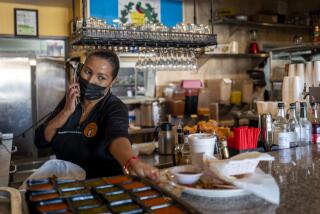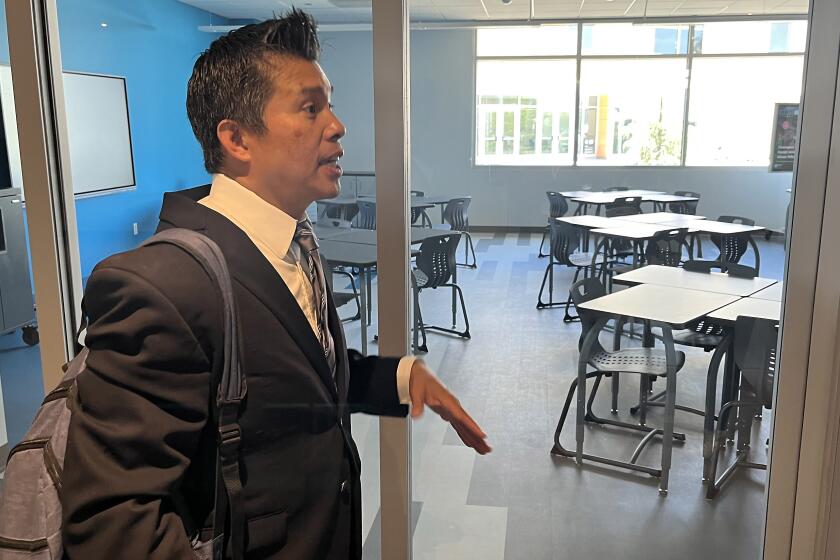California aims to fully reopen its economy June 15

- Share via
California is aiming to fully reopen its economy June 15, more than a year after the COVID-19 pandemic upended the lives and businesses of millions across the state.
Officials emphasize the move hinges on two factors: a sufficient vaccine supply and stable and low hospitalization numbers.
There also will not be a full return to pre-pandemic life. Notably, California’s mask mandate will remain in place.
But officials expressed confidence that the state, through continued improvement in its coronavirus metrics and the steady rollout of vaccines, is now positioned to begin actively planning for what comes after COVID-19.
“With the expectation of an abundance of doses coming in from the federal government through the end of this month and into May, we can confidently say by June 15 that we can start to open up as business as usual — subject to ongoing mask wearing and ongoing vigilance,” Gov. Gavin Newsom said during a news conference in San Francisco on Tuesday.
“So this is a big day.”
As California reopens further, wariness remains more than a year since the COVID-19 pandemic began. Residents wonder: Is it too soon to return to normality?
June 15 is expected to be the end of California’s current reopening roadmap, which sorts counties into one of four color-coded tiers based on three metrics: coronavirus case rates, adjusted based on the number of tests performed; the rate of positive test results; and a health-equity metric intended to ensure that the positive test rate in poorer communities is not significantly higher than the county’s overall figure.
“The entire state will move into this phase as a whole. This will not be county-by-county,” Dr. Mark Ghaly, California’s health and human services secretary, said in a call with reporters.
In a statement, officials said those sectors included in the state’s reopening blueprint will be allowed to “return to usual operations in compliance with Cal/OSHA requirements and with common-sense public health policies in place, such as required masking, testing and with vaccinations encouraged. Large-scale indoor events, such as conventions, will be allowed to occur with testing or vaccination verification requirements.”
Ghaly emphasized that, “if we see any concerning rise in our hospitalizations, we will take the necessary precautions. But right now, we are hopeful in what we’re seeing as we continue to build on the 20 million vaccines already administered.”
Though state officials said they will keep a watchful eye on vaccine supply and hospitalizations — including how many fully vaccinated people end up requiring that level of care — they did not establish any hard benchmarks to determine whether California is ready to progress.
“We don’t have a specific number, per se, on the hospitalizations, but are looking at impacts on hospital capacity and the delivery systems’ ability to continue to deliver routine care,” Ghaly said.
On Monday, 1,989 coronavirus-positive patients were hospitalized in California — with 493 of them in intensive care. The state hasn’t seen numbers that low since last spring.
Part of the reason June 15 was chosen as the target date, Ghaly said, was that it falls two months after the state will extend vaccine eligibility to anyone 16 and older.
“We wanted to be able to provide at least a couple of weeks, two to three weeks, for individuals interested in getting vaccinated who suddenly become eligible on April 15 to get in line to get their vaccines started,” he said.
The timeline for full vaccination depends on what type of shot is administered. Ghaly noted that the longest time frame is associated with the Moderna vaccine — which has a four-week gap between first and second doses.
Health officials consider someone to be fully vaccinated two weeks after they receive their final dose.
The complex logistics of awakening 1,400 Los Angeles schools is reaching a crescendo this week with officials especially focused on safety.
To date, providers throughout California have administered 20.3 million total COVID-19 vaccine doses, and 34.2% of residents have received at least one shot, according to data from the U.S. Centers for Disease Control and Prevention.
Roughly 18.1% of Californians are fully vaccinated.
Nationwide, 32.4% of Americans have received at least one dose, and 18.8% are fully vaccinated, CDC data show.
Along with progress on the vaccine front, officials noted that California has one of the lowest coronavirus case rates in the nation — a welcome development as other areas of the country contend with new spikes of the illness.
According to data from the CDC, California’s latest seven-day new case rate of 45.5 per 100,000 people per day is the fourth-lowest among all states and significantly below the nationwide rate of 133.8.
Climbing case rates have been seen in Michigan with 471 per 100,000 people; New Jersey, 335; New York City, 307.7; the rest of New York state, 248.7 and Pennsylvania, 235.4.
Among larger states, the comparable rates over the same time period were 171.7 in Florida and 62.3 in Texas.
However, Newsom acknowledged that California could have to reapply restrictions if variants of the virus cause cases to significantly increase.
“This is really a race, these vaccines against the variants, against the mutations,” he said.
But with continued masking and safety precautions, the governor said he doesn’t anticipate California will reverse course.
“We’re always going to be led by data, led by reality and the lived experience on the ground,” Newsom said. “But our expectation is, if we’re vigilant, if we don’t spike the ball, if we don’t announce mission accomplished, and continue to do the good work that we’ve done, that by June 15, we’ll be beyond that blueprint and we’ll be back to a sense of normalcy.”
The existence of a coronavirus variant containing two worrisome mutations, first discovered in India two weeks ago, is confirmed in California.
A successful statewide reopening in June confers a major political upside for the governor, who faces a likely recall election in the fall.
Newsom’s chances of surviving a recall could be higher if Californians have resumed some form of pre-COVID-19 life when they cast their ballots. Mass vaccinations and the return of in-person education are critical to that sense of normality.
Newsom was the first governor in the nation to issue a stay-at-home order in the early days of the pandemic last year, an action widely cast as the right call to protect California’s fragile healthcare system.
The governor hasn’t received the same praise for his handling of reopenings.
Health experts have said Newsom lifted restrictions too quickly and didn’t reinstate them fast enough when case numbers grew, adding to COVID-19 surges in the summer and winter. Ghaly, one of the state’s top health officials, has said he would have slowed the pace of change last summer if he could do it all again.
Rescinding restrictions and launching a sweeping reopening create new risks for Newsom. If the virus surges again or unexpected problems arise, the whiplash of the governor’s constantly changing rules could be fresher in the minds of voters, who may blame him at the polls.
Political experts say the more Californians think of the pandemic in the past tense, the more likely Newsom is to keep his seat.
Gov. Gavin Newsom’s political survival hinges on how Californians feel about their lives and their governor in the fall when they will probably cast their ballots. And already, voters are more confident about the future — and Newsom — as vaccinations increase in the state and more people begin to envision a return to normal life.
The announcement of the targeted reopening date came the same day that California hit its goal of administering 4 million COVID-19 vaccine doses in its most vulnerable communities — a milestone not only in the ongoing struggle to more equitably give out the precious shots, but in the push to further reopen the state’s economy, even ahead of June 15.
Upon hitting the target, the state redrafted its reopening roadmap to implement new criteria allowing counties to more quickly relax some of the restrictions on businesses and public spaces.
The tiers outlined in California’s current reopening strategy go from purple, in which coronavirus transmission is considered widespread, and indoor business operations are severely limited; to red, with fewer restrictions; to orange, with even fewer; and finally, yellow, in which most businesses can open indoors with modifications.
Before Tuesday, counties had to record fewer than 4.0 new cases per day per 100,000 people to move into the orange tier. With the 4-million dose target now achieved, the requirement has been loosened to under 6.0.
County officials say moving to a less restrictive category in California’s reopening blueprint is a hard-fought gain in the battle against COVID-19.
Under the new criteria, 15 counties — Contra Costa, El Dorado, Humboldt, Imperial, Mendocino, Monterey, Napa, Riverside, San Benito, San Bernardino, San Diego, Siskiyou, Sonoma, Tulare and Ventura — officially moved from the red to orange tier this week.
San Joaquin County escaped the purple tier, leaving only two counties, Inyo and Merced, still subject to the state’s strictest COVID-19 rules.
Even though the state also relaxed the criteria for reaching the most lenient yellow tier — to an adjusted daily new case rate of below 2 per 100,000 people, up from the previous requirement of less than 1 — only two counties, Alpine and Sierra, have made it that far.
All told, 32 of California’s 58 counties, representing roughly 80% of the state’s population, are now in the orange tier; and 22, home to nearly 19% of Californians, are in the red tier.
California continues to buck the COVID-19 spring surge. But are there causes for concern?
Moving into the orange tier has significant economic implications — though counties can always opt to maintain stricter rules in place, if they choose.
Counties can allow bars, which no longer are required to serve food, to reopen outdoors with some modifications.
Amusement parks can reopen at up to 25% capacity, and fan attendance is allowed at 33% capacity for outdoor sports and live performances.
Bowling alleys, card rooms and satellite wagering sites also can reopen, each at 25% capacity and with certain modifications.
Capacity restrictions can also be lifted in stores, although social distancing and other safety modifications still apply. Accommodations can also be increased at houses of worship, museums, zoos and aquariums; restaurants and movie theaters; and indoor gyms and yoga studios.
Offices in nonessential industries can reopen, though the state says workers should still be encouraged to work remotely.
President Biden announces he’s moving up the deadline for states to make all adults eligible for COVID-19 vaccines to April 19.
The state-set goal of administering first 2 million, then 4 million doses in targeted communities — namely, those in the lowest quartile of a socioeconomic measurement tool called the California Healthy Places Index — is one aspect of a wider effort aimed at ensuring equitable access to COVID-19 vaccines.
California has for the last month earmarked 40% of its COVID-19 vaccine supply for residents in those disadvantaged areas, an allocation state officials said would not only help address inequities in the inoculation rollout, but make sure the shots are available to those most at risk from the pandemic.
More to Read
Sign up for Essential California
The most important California stories and recommendations in your inbox every morning.
You may occasionally receive promotional content from the Los Angeles Times.





















